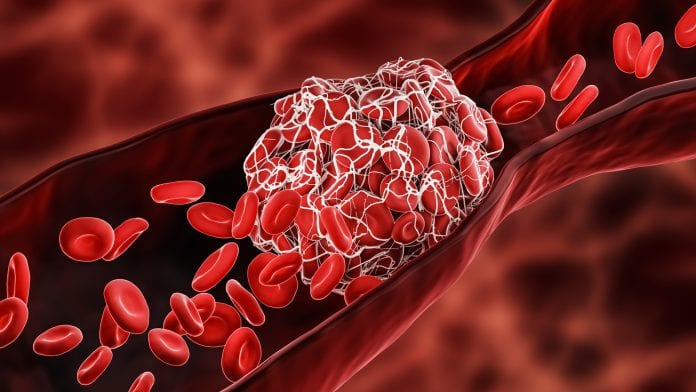
A breakthrough in the understanding of why blood clots form in the lungs could lead to improvements in preventative treatment.
Researchers from the University of Leeds and the University of Sheffield have discovered a key mechanism in preventing the escalation of blockages caused by blood clots.
A blood clot forms a pulmonary embolism or blockage, cutting off blood flow to major blood vessels in the lungs. In many cases, the blockage is caused by fragments that have broken away from a blood clot elsewhere in the body, such as a deep vein thrombosis in one of the legs. The fragments are transported to the lungs via the blood stream. Now, researchers have discovered that the protein fibrin plays a key role in stabilising the original clot to prevent bits of clot from breaking loose.
The findings from the research, which was funded by the British Heart Foundation, have been published in the scientific journal PNAS.
The role of fibrin
The research team used animal studies involving mice to investigate a key chemical building block of the clotting protein fibrin, known as γ-chain cross links. The scientists found that the γ-chain cross links give the fibrin its stability through enhanced resistance to rupture and clot fragmentation.
The study examined clot behaviour in mice that were genetically modified so they could not produce the stabilising γ-chain cross links in the fibrin, and compared them with mice that could.
The results revealed that the clots without the γ-chain cross links were more unstable and more likely to fragment and produced more associated embolisms.
Dr Cédric Duval, the study’s lead author and lecturer in the School of Medicine at Leeds, said: “What we believe is happening is that, without the γ-chain cross links, the fibrin is not strong enough to hold the clot in place against the forces generated in the body from muscle movement and from blood flow.”
Identifying new targets for drugs
Professor Robert Ariëns, also from the School of Medicine at Leeds, who supervised the research, said: “The findings reveal the importance of the γ-chain cross links. These are the structural supports in the fibrin that keep the clot in place.
“By identifying the structural dynamics of this mechanism, we have identified new targets for drugs that could be developed to stop fragments of a thrombosis breaking away to cause an embolism in the lungs.
“This is a disease that is a major cause of disability and death around the world.”
The research findings confirm the long-held suspicion by Professor Ariëns that the structure of fibrin plays a role in the fragmentation of clots – but, until now, there was no scientific evidence.
He said: “I have always thought that the remarkable elasticity of fibrin, which has been described as like rubber or spider silk, would be important to prevent clot fragmentation and thus thromboembolic disease.
“I was astounded to see the level of differences in pulmonary embolism that resulted from a genetic mutation that resulted in reduced elastic recovery of the fibres. So, when I saw the results, it definitely was a ‘wow moment’ and I also had the ‘I told you so’ feeling.”






















